The 7 Fundamentals of Choosing Plants for Skinny Side Gardens
There's a lot to consider when picking plants for those tight narrow areas alongside the house, so where to start?
We’ve all seen those sad, skinny spaces where homeowners have given up trying to create gardens because they’re too shady, too hot, too windy or too difficult to access. You may have a side passage like that in your property. With increasing housing density in Australia and New Zealand, tight spaces are becoming the norm in our gardens. But don’t leave them in the too-hard basket or, worse still, to be overrun by weeds. There are plenty of tough, easy-care plants that can cope with the difficult conditions narrow spaces present, whether they’re sunny or shaded, damp or dry. Here are some ideas to get you inspired.
For the middle layer plant shrubs (ideally ones that can be clipped to fit into the confined space), smaller palms and upright perennials such as taro, flaxes, Dietes and Dianella. Finally, plant the floor or fill in the gaps around paving with groundcovers, mixing two to three species to create variety if desired.
2. Pleach trees for privacy
If you have a formal garden, plant trees that can be pleached in the side areas. Pleaching, sometimes known as hedging on stilts, involves trimming the foliage into a rectangular shape and leaving trunks bare, as shown here. This keeps trees to the height you desire for privacy without blocking out sunlight. It also allows space below for more plants.
Most small-leaved trees can be pleached and popular evergreen favourites in Australasia are Ficus species, Magnolia grandiflora ‘Little Gem’, Pittosporum and Olearia species, Portuguese laurel (Prunus lusitanica) and olives.
If you have a formal garden, plant trees that can be pleached in the side areas. Pleaching, sometimes known as hedging on stilts, involves trimming the foliage into a rectangular shape and leaving trunks bare, as shown here. This keeps trees to the height you desire for privacy without blocking out sunlight. It also allows space below for more plants.
Most small-leaved trees can be pleached and popular evergreen favourites in Australasia are Ficus species, Magnolia grandiflora ‘Little Gem’, Pittosporum and Olearia species, Portuguese laurel (Prunus lusitanica) and olives.
3. Choose the right plants for your location
Even though many side gardens are sheltered spaces, plants will do better if they are naturally suited to the location. In this sunny Perth, WA, coastal garden by Tim Davies Landscaping, drought-tolerant frangipani and succulents (seen in the foreground) are flourishing while tough little mondo grass planted below the steps adds lush greenery to the composition.
Other small trees suitable for sunny (north- or west-facing) coastal side gardens include Australian wattles and willow myrtle (Agonis flexuosa), NZ puka (Meryta sinclairii) and Olearia species, as well as crepe myrtle (Lagerstroemia indica) and olives.
Even though many side gardens are sheltered spaces, plants will do better if they are naturally suited to the location. In this sunny Perth, WA, coastal garden by Tim Davies Landscaping, drought-tolerant frangipani and succulents (seen in the foreground) are flourishing while tough little mondo grass planted below the steps adds lush greenery to the composition.
Other small trees suitable for sunny (north- or west-facing) coastal side gardens include Australian wattles and willow myrtle (Agonis flexuosa), NZ puka (Meryta sinclairii) and Olearia species, as well as crepe myrtle (Lagerstroemia indica) and olives.
4. Accentuate the verticals
When a garden is tight and narrow, take the eye upwards to increase the sense of space. In this sunny Clifton Hill, Victoria, garden designed by Eckersley Garden Architecture, columnar conifers, tall red hollyhocks and a vivid red boungainvillea climbing high above the fence create plenty of interest as you walk along the stepping-stone path, edged by an informal hedge of rosemary.
For a similar Mediterranean ambience in a sunny west- or north-facing side garden, consider low-maintenance shrubs such as lavender, Australian coastal rosemary (Westringia fruticosa), dwarf bottlebrush (Callistemon ‘Little John’), Santolina, Teucrium, New Zealand Corokia and Coprosma species, flaxes, Dianella and Lomandra species.
When a garden is tight and narrow, take the eye upwards to increase the sense of space. In this sunny Clifton Hill, Victoria, garden designed by Eckersley Garden Architecture, columnar conifers, tall red hollyhocks and a vivid red boungainvillea climbing high above the fence create plenty of interest as you walk along the stepping-stone path, edged by an informal hedge of rosemary.
For a similar Mediterranean ambience in a sunny west- or north-facing side garden, consider low-maintenance shrubs such as lavender, Australian coastal rosemary (Westringia fruticosa), dwarf bottlebrush (Callistemon ‘Little John’), Santolina, Teucrium, New Zealand Corokia and Coprosma species, flaxes, Dianella and Lomandra species.
5. Keep it simple
If your side area is very small, restrict the number of plants you use to two to three in order to avoid a busy look, as shown here in this formal garden in Sydney, NSW. Trained overhead is a beautiful wisteria vine while a tall hedge creates a green wall to ensure privacy. A clipped evergreen box hedge is planted on either side of the shady path.
Other low-planting options for lining paths in narrow shaded areas (south- and east-facing gardens) are azalea, Lonicera, Liriope muscari, Clivia, Hosta, Heuchera, mondo grass, and some Dianella species.
If your side area is very small, restrict the number of plants you use to two to three in order to avoid a busy look, as shown here in this formal garden in Sydney, NSW. Trained overhead is a beautiful wisteria vine while a tall hedge creates a green wall to ensure privacy. A clipped evergreen box hedge is planted on either side of the shady path.
Other low-planting options for lining paths in narrow shaded areas (south- and east-facing gardens) are azalea, Lonicera, Liriope muscari, Clivia, Hosta, Heuchera, mondo grass, and some Dianella species.
For sunnier north- and west-facing areas, line side paths with black mondo grass as shown here in this Christchurch, NZ, garden by Goom Landscapes, or use dwarf Dianella species. For foliage contrast, add a low clipped hedge of Australian shrubs such as Murraya paniculata and dwarf bottlebrush (Callistemon ‘Little John’) or New Zealand natives such as Corokia ‘Silver Prince’ or Coprosma ‘Karo Red’.
6. Create a jungle effect
In warm areas, turn moist and shady side gardens (south- or east-facing) into a lush, green jungle. Add white paving stones as shown here to contrast with the array of different greens. In this Auckland, NZ, garden designed by Jules Moore for Zones Landscaping Specialists, Bangalow and Kentia palms are underplanted with vibrant subtropical foliage such as Maranta and bromeliads. For a similar effect you could also use tractor seat plant (Ligularia reniformis), Farfugium, Colocasia, Ctenanthe, Aspidistra and Rodgersia.
In warm areas, turn moist and shady side gardens (south- or east-facing) into a lush, green jungle. Add white paving stones as shown here to contrast with the array of different greens. In this Auckland, NZ, garden designed by Jules Moore for Zones Landscaping Specialists, Bangalow and Kentia palms are underplanted with vibrant subtropical foliage such as Maranta and bromeliads. For a similar effect you could also use tractor seat plant (Ligularia reniformis), Farfugium, Colocasia, Ctenanthe, Aspidistra and Rodgersia.
To create a vertical dimension in jungle-themed side gardens, some gardeners also opt for banana palms (pictured), bamboo, and Giant Bird of Paradise (Strelitzia nicolai). Note the blue-flowering echium creating a focal point at the end of this side garden in Melbourne, Victoria.
7. Add fragrance
Perfumed plants can turn an ordinary side passage into a special feature. The narrower the space, the more you will be able to appreciate the fragrance. Dress up boundary structures with pretty climbing plants such as this scented Chilean jasmine (Mandevilla laxa), which prefers warm sunny areas with good moisture.
Perfumed plants can turn an ordinary side passage into a special feature. The narrower the space, the more you will be able to appreciate the fragrance. Dress up boundary structures with pretty climbing plants such as this scented Chilean jasmine (Mandevilla laxa), which prefers warm sunny areas with good moisture.
Other scented climbers for sun or partial shade include star jasmine, Carolina jessamine (Gelsemium sempervirens) and Stephanotis floribunda (frost-free areas only). For further interest, try training climbers into interesting shapes as shown here with this star jasmine trained into diamond shapes in a narrow garden by Hedge Garden Design & Nursery in Wellington, NZ.
Tell us
How have you planted the narrow spaces in your skinny garden? Tell us in the Comments below, save your favourite images and join the conversation.
More
Looking for more garden advice. Read How to Choose the Best Plants for a Small Garden
Tell us
How have you planted the narrow spaces in your skinny garden? Tell us in the Comments below, save your favourite images and join the conversation.
More
Looking for more garden advice. Read How to Choose the Best Plants for a Small Garden





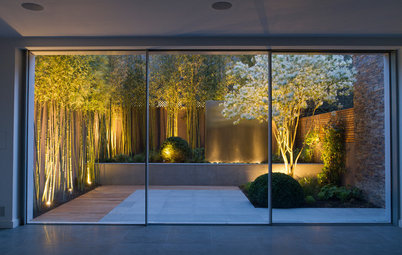
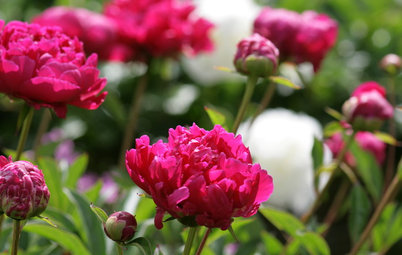
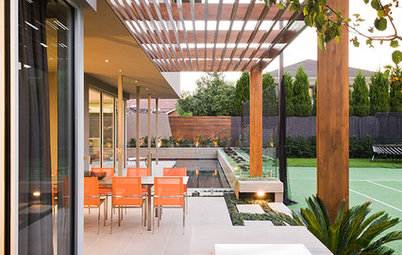
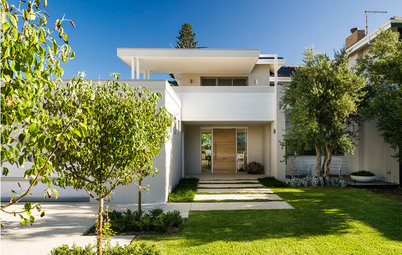
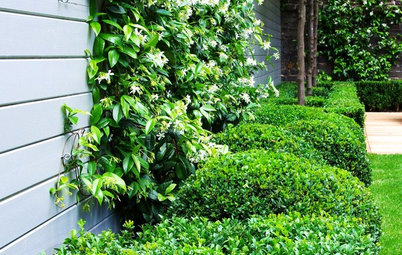
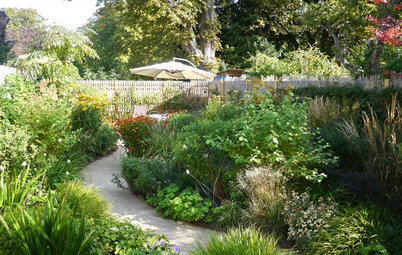
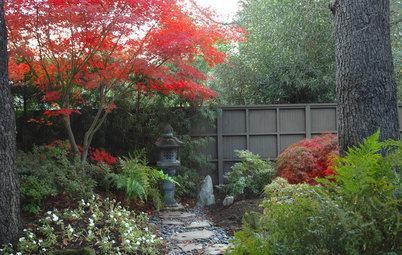
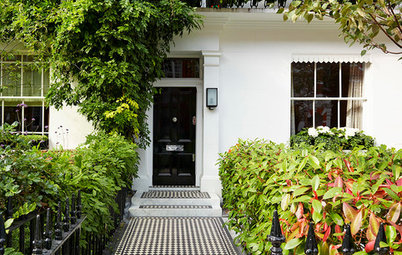

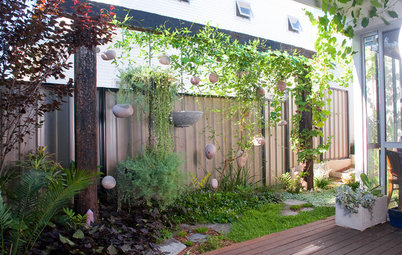
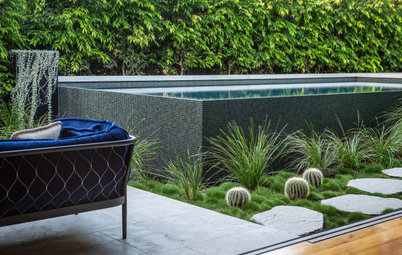
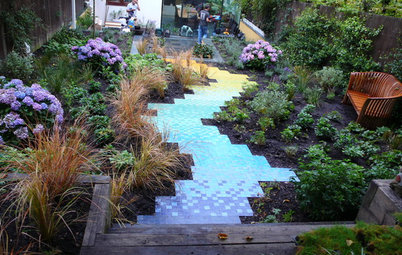
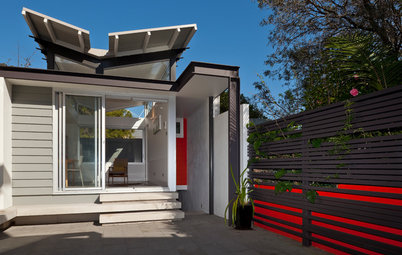
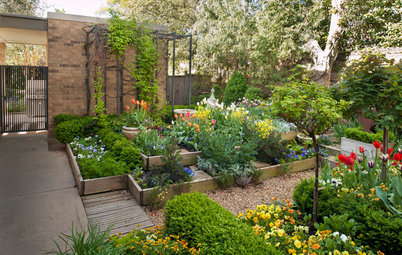
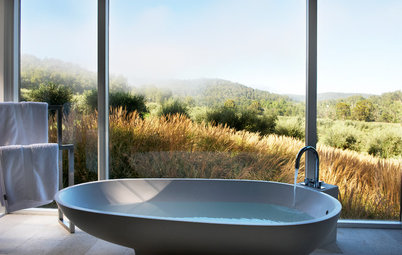
The best way to create a verdant, plant-filled paradise in a tight space is to plant in layers. Upright trees such as the palms used here are best for the top layer. You could also use New Zealand cabbage trees (Cordyline species) or columnar conifers. Climbing plants trained to grow up vertical supports are another option.